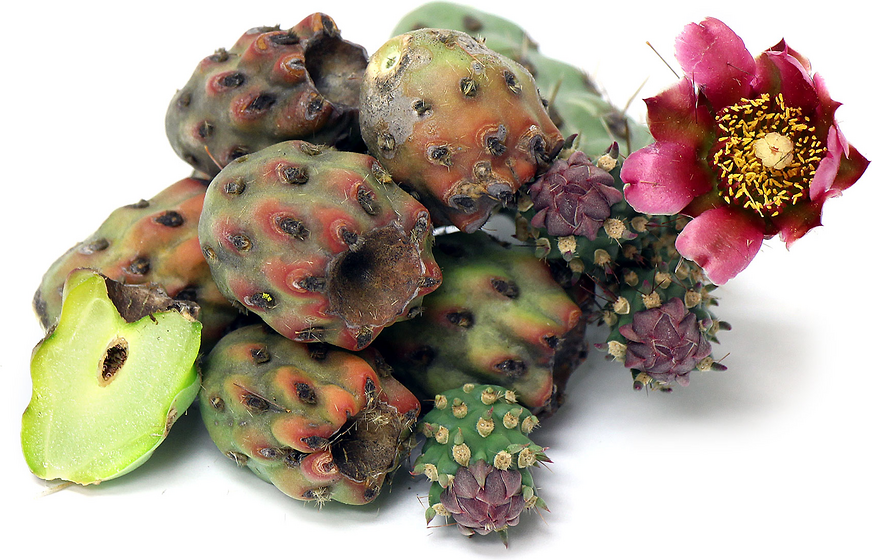


Cholla Cactus Buds
Estimated Inventory, lb : 0
Description/Taste
Cholla Cactus buds emerge in clusters from the Cholla Cactus, which stands up to 3 meters tall and features branching cylindrical segments covered in spines. These tender, thumb-sized buds represent the plant's fresh growth, boasting a greenish-gray hue with reddish-purple tips. The buds' exterior is densely covered with fine, sharp barbs known as glochids, hair-like spines that can easily be removed to reveal the bud's rugged and bumpy surface. The flowers that bloom from these buds display vibrant shades ranging from bright pink to magenta and occasionally red or yellow. Inside, Cholla Cactus buds are light green with a moist, crisp texture and a viscous quality reminiscent of okra. They emit a mild, fresh, vegetal scent akin to other succulents that intensify upon cooking, transforming into a more robust, sweeter, and earthier aroma. The buds' flavor is similar to asparagus, green beans, and artichokes, with a distinctive lemony undertone.
Seasons/Availability
Cholla Cactus buds are available from March to June.
Current Facts
Cholla Cactus buds originate from the Cylindropuntia genus within the Cactaceae family, a diverse group that also encompasses the Opuntia genus, known for species such as the prickly pear cactus. Edible buds across all Cholla Cactus species can be foraged and prepared using similar culinary techniques. This includes a variety of species, such as Snake Cholla, Coast Cholla, Buckthorn Cholla, Staghorn Cholla, and Pencil Cholla. Each year, Cholla Cactus buds are an anticipated foraged delicacy throughout the Sonoran Desert. The buds are relatively unknown outside of communities in the Southwestern United States and Northwestern Mexico, but despite their rarity, they are increasing in value among chefs and home cooks for their nutritional components and culinary uses.
Nutritional Value
Edible Cholla Cactus buds are a significant source of calcium, with just two tablespoons surpassing the amount found in a glass of milk. This makes them particularly beneficial for nursing mothers who require additional calcium for milk production. Cholla Cactus buds are rich in complex carbohydrates and soluble fibers, such as pectins, which are thought to help regulate blood sugar levels. Their slow sugar release during digestion means they could be helpful in the dietary management of diabetes, possibly decreasing the need for insulin. The Cholla Cactus boasts a variety of medicinal applications: its fruit serves as a diuretic and alleviates urinary tract discomfort, the sap offers anti-inflammatory benefits, the roots are believed to prevent kidney stones, and the buds act as a natural laxative.
Applications
Cholla Cactus buds can be eaten fresh, dried, boiled, pickled, or roasted. Before using, the buds must be de-spined, which can be done manually or by charring them in a smoldering fire pit. Cholla Cactus buds can be tossed into salads, diced for omelets, folded into burritos, sautéed with herbs, or used in stews and soups. When marinated, Cholla Buds can complement antipasto platters and add flavor to vegetarian dishes and stews. Their tangy juice lends itself well to creating zesty drinks, syrups, jellies, and smoothies. Cholla Cactus buds pair well with ingredients like lemon, lime, orange, cilantro, mint, cumin, tomatoes, onions, corn, beans, queso fresco, cotija cheese, and grilled meats. It is recommended that the buds be used within a few days of harvest for the best quality and flavor.
Ethnic/Cultural Info
Indigenous cultures of the Southwest, especially the O’odham people of the Sonoran Desert, have long cherished Cholla Cactus buds as a staple of their diet and seasonal traditions. Harvesting these buds marks a significant communal event inherited from their ancestors, the Hohokam, who also relied heavily on Cholla buds for sustenance. Beyond the buds, various parts of the Cholla Cactus serve both culinary and practical purposes. The wood from Cholla Cactus branches can be utilized for fuel. After the branches have decayed, they leave behind intricately patterned “skeletons” that are transformed into items such as walking sticks, souvenirs, and artwork.
Geography/History
Cholla Cactus, native to the rocky terrains of the American Southwest, is especially fruitful in the Sonoran Desert and the sunny hillsides and deserts of West Texas. Though adaptable to the cold conditions of the high desert, warmer climates are known for producing the best Cholla Cactus buds. Primarily cultivated in home gardens and landscapes, Cholla Cactus works well for xeriscaping, a landscaping approach that minimizes the need for supplemental water through irrigation. During the COVID-19 pandemic, there was a marked increase in the pursuit of health-conscious and immune-boosting foods, a trend that extended to the foraging of Cholla buds. This growing appetite for native and sustainable foods prompted some companies to harvest, de-thorn, and market Cholla Cactus buds, available dried or pickled on health food shelves and in specialty stores.
Recipe Ideas
Recipes that include Cholla Cactus Buds. One
| Honest Food dot Net |
|
Southwest Teal in a Jar |
| Savor the Southwest |
|
Botones de Cholla en Mole Pipian Rojo |
| Edible Phoenix |
|
Traditional Sauteed Cholla Buds |




